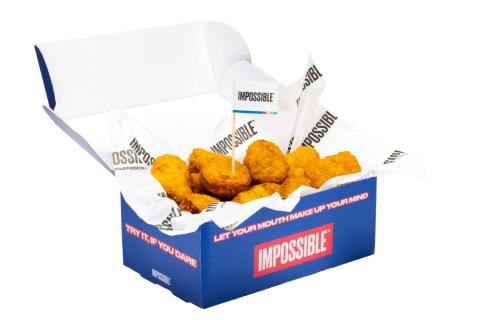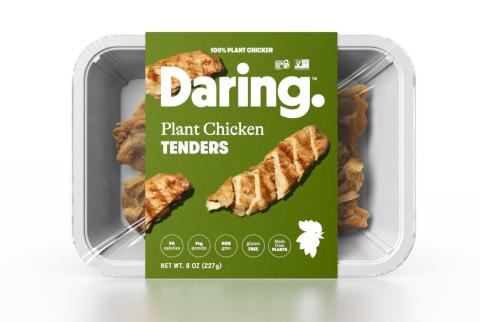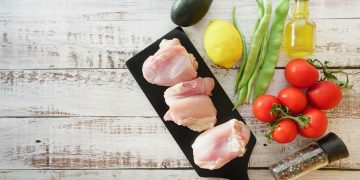Now that meatless burgers and crumbles created as alternatives to beef have become commonplace at grocery stores and restaurants across the country, alternative protein providers are intent on conquering the chicken and pork categories with a range of frozen, refrigerated, and even shelf-stable products designed to steal share from comparable items made from animal proteins.
Among these alternative products are Amazon Fresh Plant-Based Chik’n Nuggets; Beyond Chicken Tenders and Beyond Sausage; Daring Plant Chicken Tenders; Impossible Chicken Nuggets, Impossible Sausage, and Impossible Pork; Jada Plant Based Porkless and Chick’n Mixes, Lightlife’s unbreaded Chicken Breast and Strips; LikeMeat’s Like Chick’n Wings; OmniFoods’ OmniPork Ground and Strips; Ozo TrueBite Plant-Based Chicken Cutlet and Shreds and Plant-Based Bacon; NotCo’s NotChicken products; Simulate Nuggs, Tenders, and Wings; and Skinny Butcher Crazy Crispy Chick’n Nuggets, among many, many others.

Although, as the Plant Based Foods Association, The Good Food Institute, and market research firm SPINS noted this past April, burgers continue to be the top-selling plant-based meat product type, the industry is meeting consumer desire for more variety within the category, with the fastest-growing plant-based meat items in 2021 including plant-based chicken nuggets, tenders, and cutlets. In fact, plant-based chicken was a growth leader last year as more products that approximate the taste, texture, and appearance of animal-based chicken arrived in stores. Altogether, alternative beef, sausage, pork, chicken, and seafood logged $1.4 billion in U.S. sales in 2021.
Regarding pork analogs, Progressive Grocer Senior Editor Lynn Petrak noted the rise of such products in her 2022 Protein Report, while global plant-based pork sales are predicted to soar from $1.2 billion in 2020 to $10.6 billion by 2030, according to market research firm Future Market Insights, with anticipated growth in North America attributed to evolving consumption patterns, the growing popularity of flexitarian and vegan diets, increasing environmental concerns, and a continuously rising demand for better-for-you products.
“Plant-based pork will … be a leader in this category,” predicts Heather Brand, category manager at Los Angeles-based online grocer Thrive Market. “There are some inspiring new brands at the forefront of this trend aiming to promote plant-based options in an industry that carries one of the largest carbon footprints. Pork alternatives will also help address food insecurity as it creates yet another protein option for consumers.”
Additionally, with an April report from integrated sales and marketing service provider Acosta revealing that more than 60% of consumers repeatedly purchase plant-based products per month, citing health as a key reason, it has become more important than ever for manufacturers and retailers to offer a greater number of alternative protein options beyond the basic burger and crumbles.

New Opportunities at Retail
Given these factors, manufacturers and retailers are embracing the opportunities presented by plant-based chicken and pork products. The first step, naturally, is to create items that pass muster with consumers.
“The main formulation challenge was finding simple and natural ingredients that when combined, created a product that mirrored chicken in every aspect, including taste and texture,” recounts Mackay, who believes that the focus of the alt meat category is headed toward whole-cut meats. “This was important, as we wanted to make sure Daring was a product that even meat eaters would love and enjoy in their traditional chicken dishes. Through a unique flavor and texture process, we were able to create a juicy, shreddable product that was even better than the animal protein.”
“Consumers want and expect an experience similar to meat when purchasing plant-based items,” asserts Chad Coester, SVP of Own Brands at Boise, Idaho-based Albertsons Cos., whose private-brand products include Open Nature Chick’n Less Nuggets and Patties. “We aimed to achieve that in a way that makes Own Brands plant-based products stand out from competitor products on the market in both quality and cost. With more consumers trying plant-based alternatives on a regular basis, we are committed to providing an innovative variety of alternatives that are not only high-quality and flavorful but also affordable.”
According to Coester, Albertsons has found editorial print ads, social media, and influencer partnerships “particularly effective” in driving awareness of its plant-based chicken and other Open Nature offerings.
“There are a number of factors that will continue to make these meat alternative products attractive to customers,” notes Daniel Litwin, VP of procurement at Delanco, N.J.-based e-grocer Misfits Market, which offers plant-based options for shoppers. “Combining the convenience of easy-to-prepare frozen items with the health and sustainability advantages of plant-based makes items like plant-based nuggets and tenders a great option. Furthermore, as the cost of real meat continues to rise to an unprecedented level, budget-conscious consumers will likely turn to plant-based options for center-of-the-plate alternatives.”

While Thrive Market’s frozen meals made with Beyond Meat plant-based protein are “some of our best-selling items in the frozen foods category,” according to Brand, the grocer also offers such plant-based fare as the Jack & Annie’s brand, which uses the jackfruit plant — often considered a substitute for pork — to create such frozen and refrigerated alternative meat products as nuggets, Buffalo wings, and sausage. “The response from our Thrive Market community has been so positive, with hundreds of four- and five-star reviews already,” she says. “We have much more coming down the pipeline as well.”
When it comes to merchandising, Brand emphasizes: “It’s important to cross-merchandise plant-based proteins alongside meat products, to make them more accessible to everyone. Meet people where they already are, instead of keeping these items in silos that have to be searched for.”
Cultivating a Following
Another alternative protein option is that of cultivated meat, including chicken and pork products. These types of emerging products were given a boost when movie star Leonard DiCaprio joined cultivated meat producers Aleph Farms and Mosa Meat as an investor and advisor last September. Other celebrity backers in the cultivated meat space include Ashton Kutcher, Bill Gates, and Richard Branson.
Cultivated meat isn’t available yet in the United States, but Eat Just Inc. is aiming to change that. Although it’s best known here for its plant-based eggs, the San Francisco-based company’s cultivated meat division, GOOD Meat, recently broke ground on the largest cultivated meat production center in Asia. The complex, scheduled to open in the first quarter of 2023 at JTC Bedok Food City, in Singapore, will have the capacity to produce tens of thousands of pounds of cultivated meat. Local production will help GOOD Meat, which created the world’s first-to-market cultivated meat products, meet rising consumer demand for its chicken offerings, which have been available for purchase in Singapore since December 2020.
Asked to define cultivated meat, with which many U.S. consumers are still unfamiliar, Andrew Noyes, VP and head of global communications and public affairs for Eat Just, described it as “safe, delicious, high-quality meat made from animal cells instead of slaughtered animals. [It’s] made by sourcing a small number of animal cells from high-quality poultry or livestock. We then feed those cells nutrients, including amino acids, carbohydrates, minerals, fats, and vitamins — the same types of nutrients animals need to grow and multiply. These nutrients, known as the growth medium, grow the cells into the meat. The entire process takes place in a safe and controlled environment much like a beer brewery.”
Challenges to widespread adoption remain, however. “Commercialization and large-scale production require substantial investments in scientific and technical expertise to reduce the cost of the nutrients needed to feed the cells and build much larger cultivators (or bioreactors) to grow the meat,” admits Noyes, who notes that GOOD Meat has partnered with two companies to help overcome these hurdles: ABEC Inc., to design, manufacture, install and commission the largest known bioreactors for avian and mammalian cell culture, and international nutrition company ADM, to lower key costs related to cultivated meat production.

As for when these products will be available in the United States, that depends on the FDA and USDA, with which companies like GOOD Meat are currently going through the regulatory process. “The first approvals of cultivated meat by U.S. regulators will be a watershed moment for the food industry and for whichever companies are first to receive approval,” says Noyes. “We hope that happens soon and that GOOD Meat is among the first to enter the market here. We have seen firsthand the enthusiasm expressed by Singaporeans who are enjoying our cultivated chicken today — and we can’t wait to bring this innovative new type of meat to American consumers.”
Whether they’re grown in a lab from animal cells or created from plant-based ingredients, it seems clear that alternatives to conventional chicken and pork, as well as other animal proteins, will continue to roll out at retail, offering more choices in more forms than ever before.
“I see the next phase in alternative proteins focusing on cleaner labels, fewer ingredients, and generally more healthy options,” predicts Misfits Market’s Litwin. “Now that it’s been proven that alternative meats can be produced at a large scale, it will be important to show that these alternatives are actually good long-term replacements not just for the earth, but for our bodies, too.”














